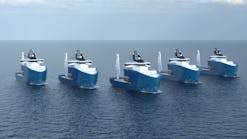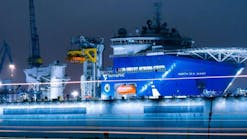Michael McGee
Quest Integrity Group LLC
Managing risk and the performance of offshore oil and gas pipelines has become increasingly important in recent years. In-line inspection (ILI) technologies remain the preferred assessment method because ILI delivers a potential for extensive evaluation and comprehensive analysis fundamental to sustained pipeline safety, effective integrity management, and optimized operations. Yet historically, design and operational challenges prevented ILI tools from inspecting many non-traditional and difficult offshore pipelines.
Advances in ILI technologies now provide operators a range of inspection options in overcoming pipeline flow, configuration, and previously restrictive environments. Today's choices, however, have a significant and varied impact on the entire asset integrity program. Acquiring accurate data, prioritizing actions based on a predictive rather than a reactive schedule, and eliminating conditions that cause interruptions are critical. Likewise, comparing ease of logistics, launching/receiving requirements, bi-directionality capabilities, performance specifications, onsite tool and data turnaround times, and data quality for advanced engineering should be considered.
Assessment methods
Pipeline failures in the oil and gas industry continue to draw attention to the effectiveness of corrosion damage assessment methods, connected regulations, and the prerequisite for accurate understanding of the physical condition of pipelines during sustained activity. Historically, pipeline assessment methods have been treated with equal prescriptive weighting. However, coupled with an aging infrastructure and increasing demands, operators are accepting that some previous systems of measurement and evaluation may no longer be sufficient for continued safe, reliable, and efficient operations.
Accepting that improved safety and optimized performance are the goals, it remains difficult to achieve in such a dynamic environment. For example:
- Acquiring, training, and retaining internal subject matter experts (SME) has become challenging with the competitive job market and personnel retiring
- Some pipeline assets must perform in conditions beyond those they were originally intended or designed
- Pipelines are acquired, not always with a complete transfer of records, pipeline familiarity, or sufficient threat assessment
- Operators "don't know what they don't know" (current inspection technology/capabilities, updated integrity strategy, unidentified threats).
Consequently, many pipeline operators are revisiting established Integrity Management Programs (IMP) with a keen eye toward more modern, more effective solutions. As the public watches, perfunctory regulatory compliance is making way for active integrity management.
Subsea considerations
Determining and prioritizing risk for offshore assets is generally no different than for onshore assets, although the consequences of failure are often elevated. ILI remains the preferred subsea inspection method because it delivers the most effective, best potential for extensive data evaluation and comprehensive analysis fundamental to sound engineering principles. Obtaining such comprehensive pipeline data is typically more difficult due to remote location, limited access, challenging design, and extreme operational parameters. Inspection options are reduced whereas expenses and timelines increase.
Even as today's ILI capabilities have improved as a whole, the continued development of deepwater fields requiring higher pressure ratings and the resultant thicker walled pipe, connectors, valves, and fittings reinforces the barriers that many existing tools face. Opportunities for better capabilities in challenging projects not only exist in transmission lines, but also for the lesser regulated production and flow lines (U.S. Department of Interior-30 CFR Part 250).
In response, we see providers pushing both the boundaries of ILI tools and what is considered conventional thinking. The traditional method of balancing known piggability limitations against budgets and comparing design or line modifications with less comprehensive integrity assessment methods is required less often. In other words, what used to be challenging is no longer the case.
Modern inspection approach
To address the opportunity in the subsea environment, ILI tools have advanced via evolution and foresight. For instance, no longer is a constant bore or 3D minimum bend radius a precondition. Presently, there are cost-effective technologies providing modern in-line inspection solutions for challenging subsea pipelines. Quest Integrity Group's InVista platform offers one such solution.
The proprietary technology is an intelligent tool capable of rapid, automated, ultrasonic (UT) inspection of unpiggable pipelines over 100 mi (161 km) long. The tool platform derives from furnace tube inspection technology and has been used to inspect refinery heater coils during short notice emergencies and plant turnarounds since the 1990s.
The unique navigational abilities of the InVista platform are reclassifying piggability. The tool was designed from the outset to successfully inspect and perform in challenging pipe systems. The design foregoes the risk associated with modifying conventional ILI tool configurations or attempting unproven design(s).
This advanced technology overcomes many operational challenges in a single package:
- All tools are bi-directional (BIDI), dual-diameter capable, and navigate multi-diameter pipelines
- All tools negotiate 1.0D bends, including back-to-back and miter bends
- All tools perform in low flow / low pressure (LF/LP) environments
- All tools can be hand-carried, lifted, loaded, and transported
- Standard passage values of 25-35% standard, using dual-diameter ≥ 40%.
Moreover, modern data acquisition and integrity assessment methods allow the best possible understanding of actual current pipeline conditions. The new platform makes use of direct measurement ultrasonics, producing higher resolution data sets with tighter tolerance and more accurate flaw sizing. Providing this data allows precise wall thickness values and deformation data in objective, absolute figures.
Because of the unique sensor configuration, the tool remains unaffected by additional signal degradation ("noise") that can diminish resolution and adversely affect defect characterization for tools that have sensors riding directly on the pipe surface. Confidence levels are inherently higher because the raw data is better.
Improved pipeline assessment
The magnitude of pipeline rehabilitation and repair work is affected by tool tolerances. "The best tolerances result in the fewest repairs" is an old saying which can mean that an operator's time and money is saved.
Accordingly, choosing to run tools with tighter tolerances increases operator efficiencies and decreases waste, allowing more effective decision-making. It is important in offshore pipelines to determine whether a particular flaw exceeds established criteria for safe and reliable operation or if it will exceed criteria before the next inspection interval.
Now, most ILI inspections in offshore pipeline systems use tools based on magnetic flux leakage (MFL) technologies. Simply put, the MFL data sets record influences to a calibrated magnet circuit based on nominal wall-thickness throughout a pipeline. Defects are identified, subjectively interpreted, and then depicted or "boxed," using length and width with a rectangle containing the corresponding wall loss data dimensions of flaws. Modern software enables analysts to estimate the geometry of the flaws (e.g., parabolic or river bottom shape) to create a richer qualitative characterization.
While software manipulation of MFL data to characterize the shape of individual flaws makes sense conceptually, it neither reduces the inherently broad tolerances in the data nor increases an operator's confidence that an indicated flaw merits excavation or further study. Such flaw-by-flaw basing in conjunction with verification is resource intensive.
Compared with MFL tools, direct measurement UT inspection offers a higher return in investment due to accuracy driven efficiencies and by providing superior results. UT inspection outputs a digital map of individual wall-thickness readings, ideally suited to effective area assessment methods such as RSTRENG and API 579 Level 2 Remaining Strength Factor (RSF) calculations.
By rapidly processing large quantities of ILI wall loss data and evaluating the MAOP at distinct locations, ranking of these MAOP values serves as a rational and rapid means to prioritize the severity of corrosion throughout a pipeline. With UT's improved confidence and precision, operators can increase profitability, maximize resources and prepare more effective risk mitigation.
Value in understanding
Offshore operators of all sizes seek ways to minimize expenditures relating to operations while at the same time maintaining safe, profitable, and compliant inspection programs. Since inspections and repairs are usually budgeted years in advance, it makes sense to plan as well as possible.
Keeping up to date with the more advanced in-line inspection and assessment technology is an initial step in reducing overall costs for non-traditional pipelines because understanding current capabilities defines the operator's return on investment. Similarly, increasing accuracy in locating and defining anomalies along with improving fitness-for-service (FFS) conditions can reduce maintenance costs while developing a better understanding of the current and future pipeline condition.
Using the detailed inspection data that an advanced UT ILI tool can provide, operators can be proactive rather than reactive in their remediation and scheduling. This practice allows for better planning of inspection frequencies, corrosion growth analysis, and repair/mitigation plans. The ability to avoid unnecessary repairs caused by overly conservative assessment methodology saves operators money for other inspection or remediation projects.
Providing an overall cost savings and a sophisticated assessment of data, FFS is particularly suited to offshore pipelines since there is an increased likelihood of flaws or other damage being present. Used to this level, however, a high resolution UT dataset combined with the FFS assessment is of enormous benefit to all pipeline assets because the real value lies in the fact that operators now have the power to predict and schedule activities before failures occur.
The general result of the FFS assessment is a go/no-go outcome based on engineering principles for continued pipeline operations and current parameters. This multi-disciplinary approach calculates the failure condition of a defect and compares it with the operating and design limitations of the structure components. When running UT tools, this is a simple, precise computation because all valid pipeline wall-thickness readings are considered. By contrast, measurements used in most MFL assessments ignore up to 99% of the wall-thickness data (Level 1 B31G modified acceptance criteria).
The FFS Level 2 assessment of metal loss determines an effective-area method where a "river bottom" profile is constructed from the wall thickness measurements, and these are used to compute revised MAOP ratings (API 579-1/ASME FFS-1 2007). These calculations are typically performed over joint sections between girth welds of pipe, although a single rating may be assigned for an entire pipe section.
Using this method results in a more technically sound MAOP and is less intensive and less subjective than flaw boxing. These advanced assessments provide the operator with greater value from each individual inspection, and now the operator can be proactive instead of reactive, addressing issues before problems arise.
Case study 1
Quest Integrity was approached to inspect three South American subsea pipelines. Line 1 was an 8-in. crude line running from a platform to shore. A geometry survey determined the scheduled MFL inspection would be blocked due to restrictions. InVista measured the minimum internal diameter (ID) at 6.77 in. (172 mm). More surprising was the identification of a 5-ft (1.5-m) section where a sleeve had been used for repair. The ID in this section expanded from 8.03 in. (204 mm) to 9.25 in. (235 mm), which would have stalled most ILI tools.
Line 2 was a 6-in. gas lift line running parallel to the previous 8-in. line. The connection between the riser and the main pipeline was made with 6-in. flexible hose, and onboard firewater pumps provided the medium without modifications to the line. A geometry survey was performed and a few restrictions were measured. Found were eight ID reductions > 8% OD. The largest of these had an ID reduction of 11.9%. Reduced at its maximum by 11.9%, the nominal ID of 6.07 in. (154.1 mm) was measured down to 5.2 in. (132.1 mm).
Line 3 was an 8-in. crude oil connector line running between two platforms. Here a gauge plate established pipeline ID from 7.28 in. (185 mm) nominal to 6.5 in. (165 mm) – a 15% reduction of the riser pipe – and also wall loss of 88%. Further, this line had limited pressure, which was insufficient for conventional ILI tools (116 psi/8 bar).
The risers of all three pipelines had been inspected separately from the main pipelines by a company that specializes in riser inspections. Several of the risers were connected to the main pipeline with a flex pipe. Although InVista does not measure the wall thickness of the flex pipe, it does provide a complete geometry reading of the flexible pipe section.
The client was pleased with the complete inspection of its pipelines. Some of the differences that the client noted were:
Ease of operation. There was no heavy lifting involved for the operators or bulky transport. The crew and handheld tools were transported to the platforms via helicopter. Time for tool set-up and launch was less than 15 min. Existing cleaning pig traps were used.
Data presentation. Within hours after the inspection, the client was presented a site completion report indicating data quality, pipeline cleanliness, and location(s) of debris.
Complete inspection. The inspection covered the complete pipeline, including the riser. Because risers are normally made of pipes that have a considerably greater wall-thickness than the main pipeline – in addition to various metallic features like attached clamps – MFL tools have difficulty measuring corrosion in the riser.
Reporting. The standard reporting time for InVista inspections is 30 days. The client was accustomed to a reporting time ranging from 45 to 90 days. The report includes the full wall thickness, deformation, and remaining strength calculations represented in a user-friendly software package.
Case study 2
In the Persian Gulf, Quest Integrity was asked to inspect a subsea pipeline that had been dormant for 2.5 years. The 6-in. multi-phase infield wellhead-to-production platform pipeline had been mothballed and no traps installed. Turnkey scope included supply of traps, connection hoses, cleaning, inspection, analysis, and a full FFS pipeline assessment report (API Level II). The engineering deliverable was valuable information for the client because they planned to reinstate the line for use following a $5 million drilling investment.
InVista identified wall thickness changes that were not in the as-built drawings and defects in that thinner section. Only minimal cleaning was required due to tolerance of the inspection tool so only two foam pigs runs were required. Good data was gathered, and the entire survey was completed in < 1.5 hr.
As-built drawings stated 0.562-in. wall (14.3-mm) for some pipe sections. However, InVista provided actual wall thickness data at 0.405-in. (10.3-mm) and identified an area of external corrosion in this thinner wall with 41% metal loss.
Some advantages associated with the technology include:
- No infrastructure modifications were required; geometry and wall thickness data provided in a single run, resulting in a cost savings for the operator
- The lightweight handheld tool was loaded into and unloaded from a single launch point, resulting in reduced safety concerns and increased operational capabilities
- Superior navigational capabilities including short radius back-to-back, unbarred off-takes, and pipe schedule changes including heavy wall
- Bi-directional, low flow/low pressure and industry leading minimized tool passage requirements
- Fully integrated, API 579 Compliant Level 2 FFS assessment included as standard deliverable.
Conclusion
Advances in modern approaches and comprehensive data assessment for in-line inspection of challenging subsea pipelines offer material improvements over past methods. Historically, the sequence of gathering overly conservative ILI data or reduced quality created a great deal of extra work, frittered away time, depleted scarce budgets, and inhibited proper prioritization.
Considering the corrosion causes and flaw calculations is critical in determining the remaining working life of the pipeline asset, its inspection interval, future repairs, and operational efficiencies. Using modern approaches, offshore operators have a better understanding of the physical condition of the pipe and the unique degradation mechanisms affecting it.
Acknowledgments
The author recognizes and thanks the Quest Integrity Group contributors who supported this paper—Nigel Baxter, Geert Bontekoe, Dan Revelle, Margo Reyna, George Simmonds, and Ray Whaley. Based on a paper presented at the Pipeline Pigging and Integrity Management Conference, Feb. 6-9, 2012, in Houston.
About the Author
Michael McGee is a technical adviser for Quest Integrity Group's Pipeline Division, a position he has held since 2009. Before joining Quest Integrity, McGee spent six years with Rosen Inspection Technologies working his way from field technician to lead area manager–technical services for North America. He has more than 10 years of oil and gas industry experience, along with more than 20 years of experience in project execution and key account management. In addition to providing client-centered pipeline integrity solutions since 2003, Michael lectures for the Petroleum Extension Service (PETEX) of The University of Texas at Austin.
Offshore Articles Archives
View Oil and Gas Articles on PennEnergy.com










